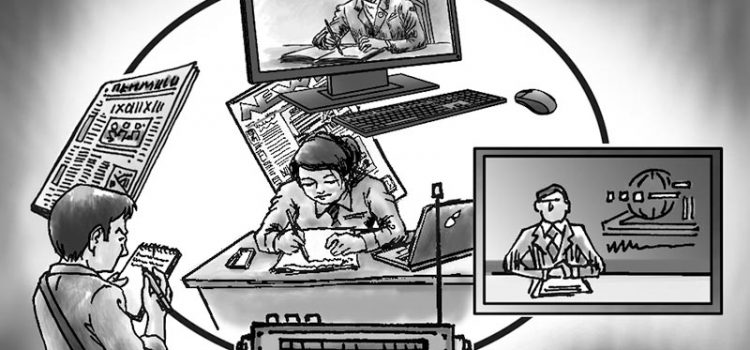SAMIKSHA KOIRALA
News media has power to take stories related to women and gender equality out of the private realm. But, when there are few female news sources, it forces audience to believe that women are unimportant or invisible.
When I started my PhD dissertation four years ago, one of my objectives was to show the changing face of Nepali women. Nepal is considered to be highly dominated by patriarchy. However, there have been several changes in our gender landscape, particularly since 1996. The change kicked off with the feminisation of the military, then of politics and the impact trickled down into other public sectors, including the media. My study’s ambition was to highlight this development by analysing gender portrayal in the news stories.
With some years of experience in journalism, I was confident that Nepali women were being more visible in the news stories. My assumption was mainly because of the significant number of female lawmakers in the then Constituent Assembly in 2008.
Similarly, number of female reporters was also on the rise.
Not just in Nepal, various global studies show gender disparity in media representations, meaning numerically there are fewer stories where women are featured as the actor or the news subject. Regardless of the choice of media (TV, radio, magazine and even online), there is also a good chance of encountering gender stereotypes.
The global studies argue that women in all types of media are sexualised and often talk less and have fewer opinions. The employment status of women and their presence in the public sphere has often been associated with the numerical representation. However, in Nepal’s context, the change in the political situation has led to many women in public roles.
Despite this significant change, the findings of my study are rather disappointing from the feminist perspective. My optimism about “change” did not last long when I started analysing my data. The findings of the content analysis show that the number of women (who were either quoted, interviewed or the subject) in Nepali news stories was limited to eight per cent in 2014.
Worse, the number has declined from 2004 where women accounted for around 14 per cent of total news stories included in the study.
Even when the time women were represented in the news stories, only one in every third news stories featured them as the central actor (main news subject) of the story. The sample of the study included around 4,000 news stories of three broadsheet dailies of Nepal from the period of 1994 to 2014. While women represent half of the world’s population, it is unjust that women’s opinions are not represented in the media.
Several efforts have been made globally to increase the number of women (in terms of representation and participation) in the news media and news stories.
The global media monitoring report of 2015 points out that there are 25 per cent of women in the news stories — heard, seen or listened — in different forms of media. The Nepali average seems to be much lower when compared to this global average.
The question arises: Why equal and fair gender media representations?
Last five decades in feminist media research has demonstrated that there is a persistent pattern of under-representation of women in the news media. It is an indisputable truth that the news media shapes our ideas including our understanding of gender and gender roles. The under-representation of women in the news media undermines women’s basic right to be heard, seen and read in the news stories.
When news sources fail to represent women in our workforce, news stories tend to express patriarchal views. News media has power to take stories related to women and gender equality out of the private realm. But, when there are few female news sources, it forces audience to believe that women are unimportant or invisible.
Similarly, misrepresentation of genders in the media may distort how we see ourselves as men or women. Emphasising on traditional behaviours/ roles of men (for example, anger in males and passiveness in females) and women may also normalise violence against women. On the contrary, stories challenging gender stereotypes can eventually empower women to take up men-dominated occupation or to speak up against the violence.
What is the way foreword then?
It may be argued that simply including women as more news subjects and interviewing more women might not transform our understanding of gender and gender roles. Yet, ensuring women as the central subject of news stories and by including more issues on women can definitely be a first step towards ensuring equal and fair media representations. Focusing the issues related to women and gender equality can be another step.
The number of female journalists in Nepal is still low at 18 per cent. Absence of women in decision-making roles in media houses is also another factor that might be hindering women’s representation in the news stories.
Media houses should take serious steps to ensure women’s equal participation and guarantee women-friendly work environments. Representing women in diverse roles which are non-stereotypical is another step. The representation of women should go way beyond than “a helpless victim”, “a submissive wife” or “a sexy model”.
Koirala holds a PhD in journalism from University of Oslo, Norway.
Source: The Himalayan Times
Date: December 20, 2018


